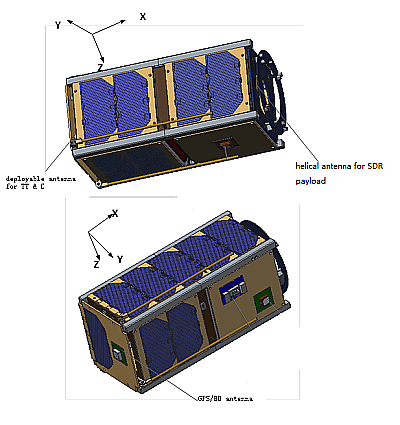TW-1A NASA-Catalog: 40928
TW-1B NASA-Catalog: 40927
TW-1C NASA-Catalog: 40926
Beacon
TW-1A 435.645 MHz 4k8/9k6 GMSK, 1W, 10 second transmit interval
TW-1B 437.645 MHz 4k8/9k6 GMSK, 1W, 20 second transmit interval
TW-1C 435.645 MHz 4k8/9k6 GMSK, 1W, 10 second transmit interval
Orbital Parameter
NORAD 40958
COSPAR designator 2015-057-A
Inclination 98.040
RA of A. Node 15.164
Eccentricity 0.0018317
Argument of Perigee 171.492
Revs per day 14.72727619
Period 1h 37m 46s (97.77 min)
Semi-major axis 7 031 km
Perigee x Apogee 640 x 665 km
BStar (drag term) 0.000082960 1/ER
Mean anomaly 188.660
TW-1A
TW-1B
The three satellites share the same subsystems and they are Structure, Thermal control, Attitude Determination and Control Subsystem (ADCS), Electrical Power Subsystem (EPS), On-Board Data Handling (OBDH), Telemetry, Tracking and Command (TT&C) subsystem.
ADCS
Three-axis stabilization and control are realized by applying a momentum wheel combined with the active magnetic control. Also a new GPS/BD receiver will play an important role in the subsystem.
EPS
The power supply system consists of 4 solar cell string panels and 4 battery string power pack. The system have 3 input channels with independent power-point setting giving an input power capacity of 30 W, the average input conversion efficiency approaches to 93%. Two regulated power buses with 3.3V@5A and 5V@4A are provided. And a battery under-voltage and over-voltage protection is designed.
OBDH
The mission computer is based on the 32-bit ARM architecture and freeRTOS real-time operating system.
Structure, Thermal control
For Sat-A, a 10 10 30 cm3 3U CubeSat structure is choose and two 10 10 20 cm3 2U CubeSat structures are choose for Sat-B and Sat-C. Passive control methods in the form of thermal coatings and insulation are preferred to control the heat radiation and absorption.
TT&C
The TT&C subsystem is consist of one half-duplex transceiver and one deployable antenna. The transceiver combines telemetry, tele-command and beacon capability in a single board and is available in 9.6 kbps GMSK downlink/ uplink. Also it can also transmit CW beacon periodically. For the convenience of most of the amateurs to listen to the satellites, we will prefer the CW beacon containing the basic information of the satellites as well as some HK. The deployable antenna system consists of four monopole aerials combined in a phasing network in order to form a signal circular polarized antenna. The antenna radiation pattern is close to omnidirectional. And they will deploy from all four sides of the structure upon command.
URL: